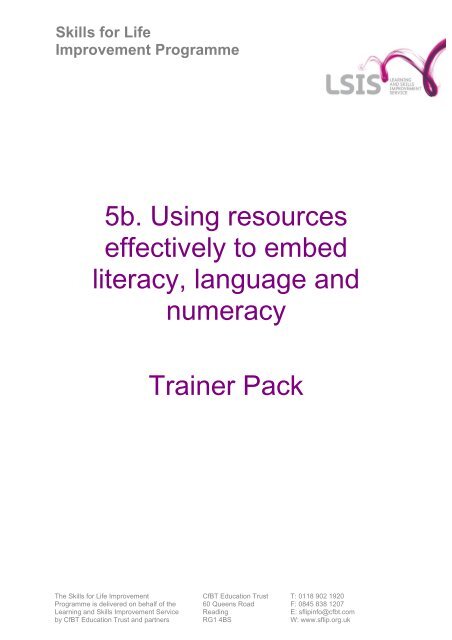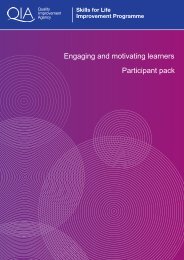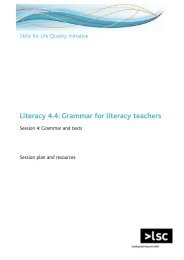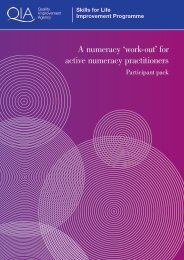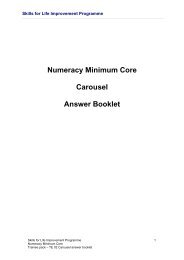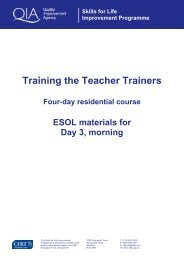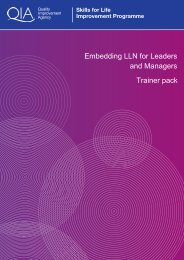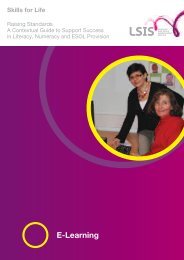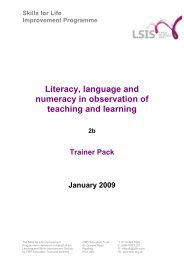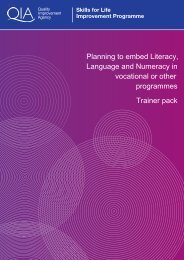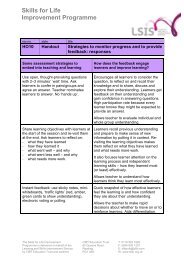Skills for Life Improvement Programme - SfLIP - Excellence Gateway
Skills for Life Improvement Programme - SfLIP - Excellence Gateway
Skills for Life Improvement Programme - SfLIP - Excellence Gateway
You also want an ePaper? Increase the reach of your titles
YUMPU automatically turns print PDFs into web optimized ePapers that Google loves.
<strong>Skills</strong> <strong>for</strong> <strong>Life</strong><br />
<strong>Improvement</strong> <strong>Programme</strong><br />
5b. Using resources<br />
effectively to embed<br />
literacy, language and<br />
numeracy<br />
Trainer Pack<br />
The <strong>Skills</strong> <strong>for</strong> <strong>Life</strong> <strong>Improvement</strong><br />
<strong>Programme</strong> is delivered on behalf of the<br />
Learning and <strong>Skills</strong> <strong>Improvement</strong> Service<br />
by CfBT Education Trust and partners<br />
CfBT Education Trust<br />
60 Queens Road<br />
Reading<br />
RG1 4BS<br />
T: 0118 902 1920<br />
F: 0845 838 1207<br />
E: sflipinfo@cfbt.com<br />
W: www.sflip.org.uk
<strong>Skills</strong> <strong>for</strong> <strong>Life</strong> <strong>Improvement</strong> <strong>Programme</strong><br />
Course<br />
In<strong>for</strong>mation<br />
Length of Session: 3 hours<br />
Target Group<br />
Job role: Practitioners of vocational or other programmes and <strong>Skills</strong><br />
<strong>for</strong> <strong>Life</strong> practitioners who are delivering embedded programmes.<br />
Organisations may choose to send pairs or teams of practitioners who<br />
are working together in the delivery of embedded programmes.<br />
Sector: Any<br />
What will the<br />
session be<br />
like<br />
The training session will provide participants with opportunity to:<br />
• identify sources of resource materials suitable <strong>for</strong> developing<br />
learners’ Literacy, Language and Numeracy skills (LLN)<br />
• review existing resources, considering their most effective use with<br />
learners<br />
• consider how to adapt resources so they are differentiated<br />
appropriately to learners’ needs<br />
• plan an activity/lesson that includes embedded LLN<br />
• reflect on their own practice and plan how to improve it.<br />
Participants will look at:<br />
• the national Embedding Learning Materials<br />
• websites and paper-based resources with embedded resources <strong>for</strong><br />
supporting learners’ LLN skills needs<br />
• planning effective activities <strong>for</strong> elements of schemes of work.<br />
Aims<br />
For participants to:<br />
• familiarise themselves with embedded resources so that they can<br />
plan effective embedded LLN activities that are engaging and<br />
meaningful<br />
2 of 49
<strong>Skills</strong> <strong>for</strong> <strong>Life</strong> <strong>Improvement</strong> <strong>Programme</strong><br />
Outcomes<br />
By the end of the session, participants will have:<br />
• selected and used appropriate parts of the Embedded Learning<br />
Materials<br />
• accessed and used a range of other suitable materials <strong>for</strong> improving<br />
learners’ LLN skills within their vocational or other contexts<br />
• learned how to adapt resources so that they are differentiated<br />
appropriately <strong>for</strong> their learners’ needs<br />
• accessed resources effectively to plan one element of a lesson<br />
• reflected on their own practice and how to improve it<br />
Course Overview<br />
Session<br />
Content<br />
1 Introduction<br />
• Introduction to course<br />
• Ice-breaker<br />
• Input on aims and objectives<br />
• Using Reflection and action log<br />
2 Embedded Learning Materials<br />
• Input on definition of embedded learning<br />
• Activity finding your way around the Health and Safety materials<br />
• Input on structure and content of Embedded Learning Materials<br />
• Input on using the Embedded Learning Portal<br />
(with trainer demonstration if internet available)<br />
• Activity identifying resources to teach fire extinguisher objectives<br />
• Activity sharing benefits and examples of peer group work<br />
• Reflecting on session 2 and planning action points<br />
3 Adapting Resources<br />
• Activity identifying barriers <strong>for</strong> learners using Hazards or own<br />
resources<br />
• Activity sharing ways to teach own or Hazards resource to<br />
learners needing skills support<br />
• Input explaining a resource already adapted<br />
• Activity reviewing types of differentiation you use and action<br />
planning <strong>for</strong> future development<br />
• Reflecting on session 3 and planning action points<br />
4 Session Planning<br />
• Sharing what your learners find difficult<br />
• Brief input on accessing Standards Unit and Move On resources<br />
• Activity planning an embedded activity/session to include one<br />
3 of 49
<strong>Skills</strong> <strong>for</strong> <strong>Life</strong> <strong>Improvement</strong> <strong>Programme</strong><br />
differentiated resource<br />
5 Reflection<br />
• Reflecting on session 4 and planning course action points<br />
This course<br />
maps to these<br />
professional<br />
standards:<br />
This course maps to the Level 5 award in Developing Embedded<br />
Approaches to Literacy, Language and Numeracy <strong>for</strong> Teachers in the<br />
<strong>Life</strong>long Learning Sector.<br />
It may provide evidence <strong>for</strong>:<br />
Level 5 Award in Developing Embedded Approaches to Literacy,<br />
Language and Numeracy <strong>for</strong> Teachers in the <strong>Life</strong>long Learning<br />
Sector:<br />
Unit 3 – ‘Planning embedded approaches <strong>for</strong> developing subject<br />
focussed knowledge and skills (element 4.2)<br />
Unit 4 – ‘Implementing embedded approaches <strong>for</strong> developing subject<br />
focussed skills’ (elements 3.1,3.2,4.1)<br />
Unit 6 – Planning embedded approaches <strong>for</strong> developing literacy and<br />
language skills (element 4.2)<br />
Unit 7 – Implementing embedded approaches <strong>for</strong> developing literacy<br />
and language skills (elements 3.1,3.2,4.1))<br />
Unit 10 – ‘Implementing embedded approaches <strong>for</strong> developing<br />
numeracy skills’ (elements 3.1,3.2,4.1)<br />
Trainer<br />
experience<br />
Trainers must have:<br />
• at least three years’ experience of teaching adult literacy,<br />
language and/or numeracy in Learning and <strong>Skills</strong> Council-funded<br />
provision<br />
• at least one year’s experience of training<br />
• a Certificate in Education or equivalent, together with specialist<br />
qualifications in teaching adult literacy, language and/or numeracy,<br />
or in working with learners with learning difficulties and/or<br />
disabilities<br />
• undertaken the core curriculum training in literacy, numeracy,<br />
ESOL, the pre-entry curriculum and/or the Access <strong>for</strong> All guidance<br />
document, or appropriate other training.<br />
Reference<br />
material <strong>for</strong><br />
trainers<br />
See Handout 10 <strong>for</strong> ‘Useful Websites’ and ‘Reference material’<br />
4 of 49
<strong>Skills</strong> <strong>for</strong> <strong>Life</strong> <strong>Improvement</strong> <strong>Programme</strong><br />
Pre-course<br />
activity <strong>for</strong><br />
participants<br />
Equipment<br />
required<br />
It would be useful <strong>for</strong> participants to access the Embedded Learning<br />
Materials <strong>for</strong> their subject / vocational area (if available) prior to the<br />
course and skim-read some of its activities.<br />
Vocational teams need to bring to the session SOW, session plans,<br />
exemplar resources<br />
To be provided by host organisation<br />
• Laptop and data projector on trainer table + projection screen <strong>for</strong><br />
projection<br />
• Flip chart and/or whiteboard and marker pens<br />
• Table to display resources<br />
• If possible,<br />
o access to PCs, one between two participants<br />
o internet connection with guest passwords as necessary<br />
o networked printer<br />
Resources<br />
needed <strong>for</strong><br />
reference<br />
during the<br />
session<br />
Provided by managing partner:<br />
none<br />
Provided by Development Adviser:<br />
• <strong>SfLIP</strong> Assessment and Learning Guidance Booklets (available<br />
from <strong>SfLIP</strong> website)<br />
• Maths4<strong>Life</strong> Thinking Through Mathematics: A practical guide to<br />
establishing and managing the mathematics footprint in<br />
educational organisations (available from<br />
http://www.nrdc.org.uk/publications_details.aspID=118)<br />
Provided by host organisation:<br />
none<br />
5 of 49
<strong>Skills</strong> <strong>for</strong> <strong>Life</strong> <strong>Improvement</strong> <strong>Programme</strong><br />
Resources<br />
needed <strong>for</strong><br />
participants<br />
to use during<br />
the session<br />
Provided by managing partner:<br />
• Participants packs with Power Point presentations<br />
• Fire Extinguisher Group Activity packs printed in colour to<br />
accompany TN2 (6 packs, each in a plastic envelope with<br />
each pack containing 1 of each sheet NOT stapled) (R1)<br />
Provided by Development Adviser:<br />
• Resources to accompany TN4 (provided on memory stick at<br />
Day 3 Briefing)<br />
Provided by host organisation:<br />
• Several copies of Health and Safety Embedded Learning<br />
Materials<br />
• Other Embedded Learning Materials appropriate to<br />
participants’ subject/vocational area<br />
• Standards Unit materials in any appropriate vocational areas<br />
• NRDC/NIACE (2007) Developing adult teaching and learning:<br />
Practitioner Guides: Numeracy, Reading, Writing, ESOL, ICT<br />
• Copies of the Core Curriculum in Adult Literacy and Numeracy<br />
• At least one copy of Access <strong>for</strong> All<br />
6 of 49
<strong>Skills</strong> <strong>for</strong> <strong>Life</strong> <strong>Improvement</strong> <strong>Programme</strong><br />
Session plan <strong>for</strong>: Using resources effectively to embed<br />
Literacy, Language and Numeracy<br />
Time<br />
10 min<br />
(10)<br />
60<br />
mins<br />
(1.10)<br />
Content<br />
Introduction and ice breaker<br />
Welcome, introductions,<br />
housekeeping<br />
Ice-breaker: human scattergram<br />
to show use of materials or<br />
stand-up, sit down activity<br />
Using Embedded Learning<br />
Materials<br />
Input using slides<br />
Activity: Fire extinguishers<br />
Purpose: Familiarise<br />
participants with Health and<br />
Safety materials<br />
Input using slides<br />
Resources<br />
No. Style Title<br />
PP1<br />
TN1<br />
PP2-<br />
3<br />
HO1<br />
TN2<br />
PP4-<br />
6<br />
PP7-<br />
9<br />
HO2<br />
PowerPoint<br />
Trainer<br />
Notes<br />
PowerPoint<br />
Handout<br />
Trainer<br />
Notes<br />
PowerPoint<br />
PowerPoint<br />
Handout<br />
Course Title<br />
Introduction and<br />
ice-breaker<br />
Aim and learning<br />
objectives<br />
Reflection and action<br />
log<br />
Using Embedded<br />
Learning Materials<br />
Definition and features<br />
of embedded learning<br />
Embedded Learning<br />
Materials<br />
Using the Embedded<br />
Learning Portal<br />
Use internet to demonstrate<br />
Embedded Learning Portal<br />
OR use slides<br />
PP<br />
10-12<br />
PP13<br />
-14<br />
PowerPoint<br />
PowerPoint<br />
Embedded Learning<br />
Portal<br />
BBC <strong>Skills</strong>wise, Bloom’s<br />
TAxonomy<br />
Input using slide<br />
Activity: Teaching about fire<br />
extinguishers<br />
Purpose: identify and adapt<br />
existing activities and resources<br />
to match a given objective<br />
Activity: Peer sharing what<br />
chose and sharing examples in<br />
teaching<br />
Purpose: to raise awareness of<br />
value of peer-sharing<br />
R1<br />
HO3<br />
HO1<br />
Resource<br />
Handout<br />
Handout<br />
Fire Extinguisher Group<br />
Activity Pack<br />
Fire extinguishers<br />
Reflection and action<br />
log<br />
7 of 49
<strong>Skills</strong> <strong>for</strong> <strong>Life</strong> <strong>Improvement</strong> <strong>Programme</strong><br />
Time<br />
40 min<br />
(1.50)<br />
60 min<br />
(2.50)<br />
Content<br />
Reflection and action points<br />
Adapting resources<br />
Input on levels using slide<br />
Activity: storming barriers to<br />
using own or Hazards handout<br />
Purpose: to raise awareness of<br />
need to adapt resources.<br />
Show slide during activity<br />
Activity: ideas <strong>for</strong> changing<br />
teaching on hazards to match<br />
learner needs<br />
Purpose: to give practice in<br />
differentiating to learner needs<br />
Input on adapted handouts<br />
Input summarising reasons<br />
learners need support and ways<br />
teachers can help<br />
Activity: Identifying<br />
differentiation methods already<br />
used and planning <strong>for</strong> more<br />
Purpose: raise awareness of<br />
need <strong>for</strong> range of differentiation<br />
methods<br />
Reflection and action points<br />
Planning an activity or<br />
session<br />
Resources<br />
No. Style Title<br />
TN3<br />
PP15<br />
-17<br />
HO4<br />
HO5<br />
HO6<br />
HO1<br />
TN4<br />
Trainer<br />
Notes<br />
PowerPoint<br />
Handout<br />
Handout<br />
Handout<br />
Handout<br />
Trainer<br />
Notes<br />
Adapting Resources<br />
Levels, adapting<br />
resources,<br />
differentiation<br />
Hazard signs and<br />
symbols<br />
Scanning <strong>for</strong> facts<br />
Differentiation<br />
Reflection and action<br />
log<br />
Planning an activity or<br />
session<br />
Activity: storming what learners<br />
find difficult in their voc areas<br />
Purpose: identify and share<br />
specific needs learners may<br />
have<br />
Refer to how to access<br />
Standards Unit materials on<br />
<strong>Excellence</strong> <strong>Gateway</strong><br />
PP18<br />
-20<br />
HO7<br />
HO 8<br />
PowerPoint<br />
Handout<br />
Handout<br />
Using resources to plan<br />
activities<br />
Finding the Standards<br />
Unit materials<br />
Finding resources on<br />
the Move On website<br />
8 of 49
<strong>Skills</strong> <strong>for</strong> <strong>Life</strong> <strong>Improvement</strong> <strong>Programme</strong><br />
Time<br />
Content<br />
Refer to embedded resources<br />
on Move On using slide and<br />
handout<br />
Resources<br />
No. Style Title<br />
HO9 Handout Planning embedded<br />
teaching and learning<br />
Activity: planning an embedded<br />
activity or lesson with one<br />
differentiated resource<br />
Purpose: to give practice in<br />
teams planning embedded<br />
activities whilst support<br />
available<br />
Show slide during activity<br />
10 mins<br />
(3.00)<br />
Reflections and action log<br />
Show slide and refer to<br />
handouts<br />
Activity: recording reflections on<br />
log section 3 and agreeing<br />
action points as a team and<br />
individuals<br />
Purpose: to try to ensure<br />
development continues after<br />
course<br />
Evaluation of course<br />
TN5<br />
PP21<br />
HO1<br />
HO10<br />
Trainer<br />
Notes<br />
PowerPoint<br />
Handout<br />
Handout<br />
Reflection and action<br />
planning<br />
What have you learned<br />
Reflection and action<br />
log<br />
Sources of embedded<br />
resources<br />
<strong>SfLIP</strong> course evaluation<br />
9 of 49
<strong>Skills</strong> <strong>for</strong> <strong>Life</strong> <strong>Improvement</strong> <strong>Programme</strong><br />
res no. style title<br />
TN1 Trainer Notes Introduction and ice-breaker<br />
Display PP1 as participants arrive.<br />
Introduction<br />
Welcome participants. Introduce self. Ask them to share names if necessary.<br />
Housekeeping: fire exits, toilets, mobiles, smoking, break<br />
Ice-breaker: human scattergram<br />
Explain to participants what a scattergram is, drawing an example on a flipchart. Tell<br />
them they are going to make a human scattergram to show their use of resources.<br />
Indicate the length of the room as the axis to show use of the Embedded Learning<br />
Materials and the width of the room as the axis to show use of the Move On website.<br />
Point out which is the low use of each, which come together in a corner of the room.<br />
Ask them to place themselves in the room according to their use of both resources.<br />
NB to trainer: if the room is unsuitable <strong>for</strong> this ice-breaker, get them to stand up or<br />
raise hands if they have used the Embedded Learning Materials and the Move On<br />
website in turn.<br />
Explain that participants will have chance in this session to explore some of the<br />
newest resources in relation to planning activities <strong>for</strong> lesson plans.<br />
Explain they will also have opportunity to share their own resources with colleagues.<br />
Display PP2 and 3 and briefly summarise aim and objectives.<br />
Explain that the first part of the course will focus on health and safety, as that topic<br />
can be shared by participants from different areas but that there will be time in the<br />
second part of the session <strong>for</strong> them to focus on resources <strong>for</strong> their own course.<br />
Reflection and action log<br />
Ask participants to take HO1 Reflection and action log from their Participant pack.<br />
Explain that participants should complete this throughout the session and that you<br />
will allow time at the end of each section <strong>for</strong> them to do this.<br />
Explain that on any Embedding CPD, they are encouraged to record their reflective<br />
thoughts, ideas and actions, to help them to develop their embedded practice.<br />
Tell them that at the end of the session you will ask them to use their reflections to<br />
write a plan <strong>for</strong> further action.<br />
10 of 49
<strong>Skills</strong> <strong>for</strong> <strong>Life</strong> <strong>Improvement</strong> <strong>Programme</strong><br />
res no. style title<br />
PP2-3 PowerPoint Aim and learning objectives<br />
11 of 49
<strong>Skills</strong> <strong>for</strong> <strong>Life</strong> <strong>Improvement</strong> <strong>Programme</strong><br />
res no. style title<br />
HO1 Handout Reflection and action log<br />
Activity Your reflections Your actions<br />
1. Embedded<br />
Learning Materials<br />
Use Health and<br />
Safety Embedded<br />
Learning Materials<br />
to plan teaching<br />
activities on fire<br />
extinguishers.<br />
Peer sharing<br />
2. Adapting<br />
Resources<br />
Ways to change<br />
resources and<br />
activities to support<br />
learners with<br />
different skills and<br />
needs.<br />
12 of 49
<strong>Skills</strong> <strong>for</strong> <strong>Life</strong> <strong>Improvement</strong> <strong>Programme</strong><br />
3. Plan an<br />
embedded activity<br />
/ lesson<br />
What learners find<br />
difficult.<br />
Writing SMART<br />
learning objectives<br />
and planning active<br />
teaching and<br />
learning to support<br />
all learners.<br />
13 of 49
<strong>Skills</strong> <strong>for</strong> <strong>Life</strong> <strong>Improvement</strong> <strong>Programme</strong><br />
res no. style title<br />
TN2 Trainer Notes Using Embedded Learning Materials<br />
What is ‘Embedded Learning’<br />
Show PP4 and PP5 to remind participants of the definition of embedding and that:<br />
• vocational skills and knowledge refers to the primary learning aims of the learner<br />
that usually lead to a qualification<br />
• there is an Adult Core Curricula <strong>for</strong> LLN (hold up Core Curricula)<br />
• embedded teaching and learning is where the relevant LLN skills are taught<br />
through the vocational context.<br />
Fire Extinguishers<br />
Explain that they are going to start with a generic Health and Safety activity.<br />
Ask them to quickly skim through the Health and Safety file on their tables and find<br />
any useful pages about fire extinguishers, jot down the page references and attach a<br />
sticky note on the top of the relevant pages, so they can find it again easily.<br />
NB to trainer: how you handle this depends on how many files you have available.<br />
Participants can work in groups taking turns or a volunteer do activity and tell others.<br />
Check they have found the activities on the Teachers’ Notes on pages 39-40.<br />
Structure and Content of the Embedded Learning Materials<br />
Use PP6 to explain the features of the Embedded Learning Materials. Explain that<br />
the LLN skills are mapped to the adult core curricula but do not set out to teach the<br />
whole LLN curricula, only those parts relevant to the vocational/subject content.<br />
Tell participants that there are two sets of materials in each file:<br />
• one in colour<br />
• one in black and white <strong>for</strong> better photocopying.<br />
The CD-ROM attached to the inside front cover (and also via Embedded Learning<br />
website) offers the pages in pdf <strong>for</strong>mat, but also in Word so that it is possible to:<br />
• adapt the layout to spread it over two or more pages<br />
• change text detail, pictures or examples<br />
• insert your own example, text or activity.<br />
14 of 49
<strong>Skills</strong> <strong>for</strong> <strong>Life</strong> <strong>Improvement</strong> <strong>Programme</strong><br />
Explain that they can find relevant sections in their Embedded Files as you explain<br />
(if files are available) and that full details of where to obtain copies are on HO10.<br />
Show PP7 to explain what is in the Teacher Notes. Mention that the differentiation<br />
sections include notes on dyslexia and language support <strong>for</strong> those who need it.<br />
Refer to Access <strong>for</strong> All.<br />
Use PP8 to explain the structure of the Learner Pages and that:<br />
• the Focus pages are intended as a summary of what the learners have been<br />
taught, <strong>for</strong> the learners to take away and review as required<br />
• the task pages ask learners to do activities.<br />
Remind participants that the embedded materials reflect the reality of the workplace<br />
and everyday settings, using realistic scenarios and documentation.<br />
Show PP9 Embedded Learning Portal and tell participants that all the Embedded<br />
Materials are available on-line on the Embedded Learning Portal. Explain there are<br />
interactive LLN activities at Milestones 7, 8; E1, 2, 3, L1, L2 and links to other sites.<br />
HO2<br />
If possible, go to the Embedded Learning Portal and demonstrate using HO2.<br />
NB to trainer: if you can’t access Embedded Portal on-line, explain using PP 10-13.<br />
If you can access the Embedded Learning Portal, do not use PP 10-13.<br />
Teaching about fire extinguishers<br />
Show PP14 to briefly remind the participants about Bloom’s Taxonomy.<br />
NB to trainer: if appropriate, refer to 5a Promoting active learning in embedded LLN.<br />
Ask them to read the three Learning Objectives on HO3 Fire extinguishers and<br />
decide which objectives are lower order and which are higher order skills.<br />
Elicit that:<br />
• Objective 1 requires lower order skills of knowledge and comprehension<br />
• Objective 2 requires the additional skill of application<br />
• Objective 3 requires the additional higher order skills of analysis and synthesis.<br />
Distribute the Fire Extinguisher Resources, one pack per table.<br />
Explain the resources are from the Health and Safety file or the Standards Unit and<br />
are provided as exemplary materials <strong>for</strong> teaching a range of objectives on this topic.<br />
Organise the participants into trios, giving each trio one of the objectives to plan <strong>for</strong>.<br />
Tell them they have 15 minutes to identify suitable teaching activities and resources.<br />
Ask them to record the activities they plan and the resources needed on HO3.<br />
Circulate encouraging discussion. Remind them about the power of active learning.<br />
15 of 49
<strong>Skills</strong> <strong>for</strong> <strong>Life</strong> <strong>Improvement</strong> <strong>Programme</strong><br />
Sharing with colleagues<br />
Ask each trio to match with another trio and to share what they chose to do and why.<br />
In the whole group, elicit what were the advantages of sharing their thoughts with<br />
their colleagues. Mention that research shows peer sharing is effective with learners<br />
at all levels.<br />
Ask if anyone has examples of effective peer sharing and scribe them onto flipchart<br />
or whiteboard. Display in room.<br />
Allow 5 minutes <strong>for</strong> participants to record their reflections on HO1 section 1.<br />
16 of 49
<strong>Skills</strong> <strong>for</strong> <strong>Life</strong> <strong>Improvement</strong> <strong>Programme</strong><br />
res no. style title<br />
PP4-6<br />
PowerPoint Definition and features of embedded<br />
learning<br />
17 of 49
<strong>Skills</strong> <strong>for</strong> <strong>Life</strong> <strong>Improvement</strong> <strong>Programme</strong><br />
18 of 49
<strong>Skills</strong> <strong>for</strong> <strong>Life</strong> <strong>Improvement</strong> <strong>Programme</strong><br />
res no. style title<br />
PP7-9<br />
PowerPoint Embedded learning materials<br />
19 of 49
<strong>Skills</strong> <strong>for</strong> <strong>Life</strong> <strong>Improvement</strong> <strong>Programme</strong><br />
20 of 49
<strong>Skills</strong> <strong>for</strong> <strong>Life</strong> <strong>Improvement</strong> <strong>Programme</strong><br />
res no. style title<br />
HO2 Handout Using the Embedded Learning Portal<br />
To find the Embedded Learning Portal, either click on the weblink here<br />
http://rwp.qia.oxi.net/embeddedlearning or type it into Internet Explorer<br />
You should see the home page, with an<br />
explanation of how to use the website.<br />
Click on the Embedded Learning tab.<br />
Type fire extinguisher<br />
into the Keywords part of the search tool<br />
and click Search<br />
Choose one of the areas found and click<br />
+ Add to saved items<br />
The sign then changes to<br />
Item saved<br />
Click on the Interactive Learning tab<br />
Click on Numeracy<br />
in the drop-down Subject box<br />
and on Entry 2<br />
in the Skill Level box, then click Search<br />
Choose an item relevant to<br />
your learners and click on the<br />
Launch e-learning link<br />
21 of 49
<strong>Skills</strong> <strong>for</strong> <strong>Life</strong> <strong>Improvement</strong> <strong>Programme</strong><br />
Explore the interactive E2 numeracy<br />
activity. When you have finished, simply<br />
click in the top right hand corner of<br />
the window to return to the portal.<br />
Now use the same techniques to explore<br />
literacy and/or ESOL<br />
When you are back at the portal page,<br />
click on Saved items.<br />
You will see a list of all the items you<br />
have saved in the current session.<br />
To store it <strong>for</strong> later use, click<br />
Store my items <strong>for</strong> later<br />
You will be given a code that allows you<br />
to retrieve the list of items from the portal<br />
anytime in the next 30 days. You can<br />
also click to return to the list of saved<br />
items.<br />
The portal links outwards to many<br />
other useful sites. Click on Links<br />
Click on the BBC <strong>Skills</strong>wise link<br />
www.bbc.co.uk/skillswise<br />
Examine some of the differentiated<br />
materials available and think how such<br />
resources could help your own practice.<br />
22 of 49
<strong>Skills</strong> <strong>for</strong> <strong>Life</strong> <strong>Improvement</strong> <strong>Programme</strong><br />
res no. style title<br />
PP10-12<br />
Powerpoint Embedded Learning Portal<br />
23 of 49
<strong>Skills</strong> <strong>for</strong> <strong>Life</strong> <strong>Improvement</strong> <strong>Programme</strong><br />
24 of 49
<strong>Skills</strong> <strong>for</strong> <strong>Life</strong> <strong>Improvement</strong> <strong>Programme</strong><br />
res no. style title<br />
PP13-14<br />
PowerPoint BBC <strong>Skills</strong>wise, Bloom’s Taxonomy<br />
25 of 49
<strong>Skills</strong> <strong>for</strong> <strong>Life</strong><br />
<strong>Improvement</strong> <strong>Programme</strong><br />
res no. style title<br />
R1 Resource Fire Extinguisher Group Activity Pack<br />
Packs will be couriered to the session by the managing partner.<br />
The resources in the pack are from the Embedding Learning Materials, Health and Safety file or the Standards Unit and are provided<br />
as exemplary materials <strong>for</strong> teaching a range of objectives on this topic.<br />
The <strong>Skills</strong> <strong>for</strong> <strong>Life</strong> <strong>Improvement</strong><br />
<strong>Programme</strong> is delivered on behalf of the<br />
Learning and <strong>Skills</strong> <strong>Improvement</strong> Service<br />
by CfBT Education Trust and partners<br />
CfBT Education Trust<br />
60 Queens Road<br />
Reading<br />
RG1 4BS<br />
T: 0118 902 1920<br />
F: 0845 838 1207<br />
E: sflipinfo@cfbt.com<br />
W: www.sflip.org.uk
<strong>Skills</strong> <strong>for</strong> <strong>Life</strong> <strong>Improvement</strong> <strong>Programme</strong><br />
27 of 49
<strong>Skills</strong> <strong>for</strong> <strong>Life</strong> <strong>Improvement</strong> <strong>Programme</strong><br />
res no. style title<br />
HO3 Handout Fire extinguishers<br />
Topic<br />
Fire<br />
Extinguishers<br />
Learning Objective<br />
By the end of the session<br />
learners will be able to …<br />
• List 4 types of fire<br />
extinguishers<br />
Teaching and Learning CC Ref. Resources including use of<br />
websites etc<br />
Course notes/book, whiteboard<br />
markers, paper, pencils, copies of<br />
HASWA<br />
• Select the fire extinguisher<br />
most appropriate <strong>for</strong> a<br />
given type of fire<br />
• Explain why a particular fire<br />
extinguisher is appropriate<br />
in a given scenario<br />
28 of 49
<strong>Skills</strong> <strong>for</strong> <strong>Life</strong> <strong>Improvement</strong> <strong>Programme</strong><br />
res no. style title<br />
TN3 Trainer Notes Adapting Resources<br />
Show participants PP15 to remind them that LLN skills levels match vocational levels.<br />
Ask if they know their learners’ assessed literacy and numeracy levels.<br />
Ask if they use this knowledge of their learners’ skills levels when planning sessions.<br />
Refer to CPD chart and point out Module 4a - Assessing learners’ needs/strengths<br />
and target-setting.<br />
Why do we need to adapt resources<br />
NB to trainer: it might be valuable to use participants’ own resources relating to their<br />
vocational area in this activity. If you do, be sensitive to participants’ feelings and use<br />
more than one resource as exemplars. Follow instructions as given <strong>for</strong> HO4 Hazards.<br />
Ask the participants to skim read HO4 Hazard signs and symbols that has been<br />
taken from the Trowel Occupations Embedded Learning Materials pages 33-34.<br />
Give them five minutes to work in their groups, to list on a flipchart or whiteboard the<br />
barriers there might typically be <strong>for</strong> their learners in reading, understanding and<br />
memorising the kind of in<strong>for</strong>mation on this handout.<br />
Ask volunteers to share in the whole group, taking an idea from each table in turn.<br />
Elicit these types of barriers:<br />
• The dense nature of the in<strong>for</strong>mation – may be too much on one page<br />
• Reading and understanding the facts may be too hard because:<br />
o there are long words to decode e.g. contaminated<br />
o some words/phrases may not be known to them e.g. static discharge<br />
• Some read very slowly because they don’t know how to scan in<strong>for</strong>mation<br />
• Some may have poor memorising strategies<br />
• Some may get bored and switch off.<br />
Adapting resources<br />
Prepare 4 sheets of flipchart paper with headings 1-4 as below.<br />
Show PP16 and ask participants to work in pairs to suggest ways they could teach<br />
the hazard signs and symbols shown on HO4 (or their own resource) to make<br />
learning more successful <strong>for</strong> these four learners:
<strong>Skills</strong> <strong>for</strong> <strong>Life</strong> <strong>Improvement</strong> <strong>Programme</strong><br />
1. a learner who requires active methods of learning<br />
2. a learner with poor reading skills (Entry 2)<br />
3. a learner who is anxious about maths<br />
4. a learner with dyslexia who has problems with short term memory.<br />
Give them 15 minutes to write activity suggestions - one idea per sticky note - and<br />
ask them to put them all on the appropriate flipchart. Display charts in room.<br />
Feedback a few key suggestions to the whole group by reading them aloud.<br />
Adapted handouts<br />
Refer to HO5 <strong>for</strong> differentiated activities <strong>for</strong> learners working below Level 1 in literacy.<br />
Talk the participants through the way the handouts have taken a small part of HO4<br />
from the Trowel Occupations Embedded Learning Materials and put in smaller steps<br />
to guide their learners through the task.<br />
Highlight:<br />
• how to scan <strong>for</strong> in<strong>for</strong>mation<br />
• the <strong>for</strong>mative assessment at the end of the first page<br />
• the use of correct text descriptors i.e. in<strong>for</strong>mation and instructions<br />
• active ways of supporting learners i.e. peer discussion and working, highlighting<br />
text, drawing, sharing memory strategies, testing each other.<br />
Differentiation<br />
Remind participants that adapting resources is part of differentiation.<br />
Show PP17 to summarise the different reasons learners may need support and the<br />
ways teachers can differentiate by adapting their resources and activities, but also by<br />
allowing more time <strong>for</strong> a task or by what outcome they expect from individuals.<br />
Refer them to HO6 and ask them to tick any ways they already use to differentiate<br />
and star any that they wish to develop in the future.<br />
Reflection<br />
Allow 5 minutes <strong>for</strong> participants to complete their Reflections and action log about<br />
adapting resources to respond to their learners’ needs.<br />
30
<strong>Skills</strong> <strong>for</strong> <strong>Life</strong> <strong>Improvement</strong> <strong>Programme</strong><br />
res no. style Title<br />
PP15-17 PowerPoint Levels, adapting resources, differentiation<br />
31
<strong>Skills</strong> <strong>for</strong> <strong>Life</strong> <strong>Improvement</strong> <strong>Programme</strong><br />
32
<strong>Skills</strong> <strong>for</strong> <strong>Life</strong> <strong>Improvement</strong> <strong>Programme</strong><br />
res no. style title<br />
HO4 Handout Hazard signs and symbols<br />
33
<strong>Skills</strong> <strong>for</strong> <strong>Life</strong> <strong>Improvement</strong> <strong>Programme</strong><br />
34
<strong>Skills</strong> <strong>for</strong> <strong>Life</strong> <strong>Improvement</strong> <strong>Programme</strong><br />
res no. style title<br />
HO5 Handout Scanning <strong>for</strong> facts<br />
The purpose of scanning is to quickly find a specific detail such as a key word, date,<br />
time or name in a piece of text.<br />
Top Tips<br />
• Don’t read every word.<br />
• Force your eyes to move rapidly across the page.<br />
• Say the word you are looking <strong>for</strong> (aloud or in your head) while scanning.<br />
• Check headings <strong>for</strong> clues to which bits of the text might be relevant.<br />
• If you are scanning <strong>for</strong> a date or time, look <strong>for</strong> numbers.<br />
• If you are scanning <strong>for</strong> a name, check words with capital letters.<br />
Scan the Top Tips above and highlight what to look <strong>for</strong> if scanning <strong>for</strong> a name.<br />
What should you not do when scanning<br />
Scan this text about explosives to answer this question:<br />
How should explosives be kept<br />
EXPLOSIVE<br />
May explode when:<br />
1. dry<br />
2. under the effect of flame<br />
3. under the effect of heat.<br />
Read and use according to<br />
instructions.<br />
Ensure containers are stored in a<br />
cool well-ventilated place.<br />
Keep lids tightly closed.<br />
Store away from sources of ignition<br />
and heat.<br />
Ensure this container and its contents<br />
are disposed of in a safe way.<br />
A. In a wet bowl<br />
B. Near a source of heat<br />
C. In a cool, well-ventilated place<br />
D. Without a lid<br />
How long did it take you to answer this question Did you scan<br />
35
<strong>Skills</strong> <strong>for</strong> <strong>Life</strong> <strong>Improvement</strong> <strong>Programme</strong><br />
Activity: Hazards<br />
Read the following text about health and safety.<br />
Some of this text gives you in<strong>for</strong>mation and some gives you instructions.<br />
In pairs discuss:<br />
• Which two boxes in the text tell you what to do, i.e. give you instructions<br />
• How do you know when you are reading instructions<br />
• Highlight the key words in the safety precautions <strong>for</strong> irritants.<br />
• Share ways to memorise these safety precautions e.g. drawing them<br />
• Test each other on what you have learnt.<br />
Hazard signs and symbols<br />
Chemical Regulations 1994<br />
Any dangerous chemicals supplied in a container must be labelled and packed in a<br />
way that will tolerate the conditions of supply and transportation.<br />
The act is designed to safeguard both people and the environment from the harmful<br />
effects of chemicals.<br />
ENSURE YOU KNOW THE FOLLOWING:<br />
THE MEANING AND<br />
CLASSIFICATION<br />
THE SAFETY<br />
PRECAUTIONS<br />
HARMFUL<br />
May cause limited health risk if:<br />
• inhaled<br />
• penetration of skin occurs.<br />
Do not breathe dust, spray or vapour.<br />
Avoid contact with skin.<br />
Wash thoroughly be<strong>for</strong>e you drink, eat<br />
or smoke.<br />
In the case of contact with eyes, rinse<br />
immediately and seek medical advice.<br />
IRRITANT<br />
May cause inflammation and irritation if:<br />
• in contact with the skin<br />
• inhaled.<br />
The contact may be:<br />
• immediate<br />
• repeated<br />
• prolonged.<br />
Do not breathe dust, spray or vapour.<br />
In the case of contact with skin, wash<br />
immediately with plenty of water.<br />
In the case of contact with eyes, rinse<br />
immediately and seek medical advice.<br />
Extract from the <strong>Skills</strong> <strong>for</strong> <strong>Life</strong> Embedded Learning Materials: Trowel Occupations pp.32-33<br />
36
<strong>Skills</strong> <strong>for</strong> <strong>Life</strong> <strong>Improvement</strong> <strong>Programme</strong><br />
res no. style title<br />
HO6 Handout Differentiation
<strong>Skills</strong> <strong>for</strong> <strong>Life</strong> <strong>Improvement</strong> <strong>Programme</strong><br />
res no. style title<br />
TN4 Trainer Notes Planning an activity or session<br />
What do learners find difficult<br />
Ask participants to work in their vocational teams of 3-6 and give them ten minutes to<br />
storm onto flipchart paper which LLN skills many of their learners find difficult.<br />
Circulate supporting them in finding appropriate specific terms <strong>for</strong> the skills e.g.<br />
• listening <strong>for</strong> in<strong>for</strong>mation or in a discussion (rather than just listening)<br />
• reading instructions or in<strong>for</strong>mation (rather than just reading)<br />
• using the 24- hour clock and timetable (rather than just maths or time)<br />
• measurement of length or area or perimeter (rather than just measurement)<br />
• speaking to customers face to face or on the phone (rather than just talking)<br />
• writing an accident report or notes on a session (rather than just writing)<br />
• reading and understanding technical vocabulary.<br />
Display them on the wall. Ask participants to do a gallery walk reading and putting an<br />
asterisk next to those skills shared by many areas, to encourage team-sharing.<br />
NB to trainer: Some teams may have mapped LLN skills needs into their SOW<br />
and/or lesson plans during or following 4b or 4c CPD sessions Planning embedded<br />
teaching and learning. If so, ask teams to compare mapped SOW <strong>for</strong> common skills<br />
needs.<br />
Standards Unit materials on the <strong>Excellence</strong> <strong>Gateway</strong><br />
Show PP18 and explain that they can find the Standards Unit materials on the<br />
<strong>Excellence</strong> <strong>Gateway</strong> by using HO7. Explain that the materials have been written as<br />
good exemplars of session plans and resources <strong>for</strong> teaching in vocational contexts.<br />
The Move On website<br />
Show PP19 and explain that participants would also benefit from exploring both the<br />
Move On Learner Route and Teacher Route more fully after the session because of<br />
the wealth of resources available there <strong>for</strong> teaching and practising LLN skills.<br />
Mention that interactive Hot Topics are to be found on the Move On Learner Route.<br />
Highlight the Maths Takeaways, quizzes and checklists available and remind<br />
participants that maths is a national priority.<br />
Briefly refer to HO8 which will help them navigate the Move On Teacher Route and<br />
find the resources made <strong>for</strong> learners training in the caring professions and the NHS.<br />
Resources can be freely downloaded from the Move On site and used or adapted.<br />
They may wish to use some Move On resources during the next activity.
<strong>Skills</strong> <strong>for</strong> <strong>Life</strong> <strong>Improvement</strong> <strong>Programme</strong><br />
Activity: plan an embedded activity/lesson<br />
Tell the participants that sitting watching slides and listening to the trainer would not<br />
have been engaging or even adequate <strong>for</strong> them to learn about resources today.<br />
They are going to work in their teams to plan an activity or lesson with embedded<br />
LLN skills that is engaging and meaningful to their vocational learners.<br />
They should include at least one differentiated resource, to support a learner working<br />
at a lower numeracy or literacy level.<br />
Agree with each vocational team an appropriate specific part of their SOW that, <strong>for</strong><br />
the next 40 minutes, they are going to work together to plan <strong>for</strong> real, Encourage<br />
referral back to the flipcharts <strong>for</strong> issues that many of their learners find difficult.<br />
They may <strong>for</strong> instance plan an activity how to embed:<br />
• listening to instructions on correct use of ratio … in brick-laying or hairdressing<br />
• accurate use of metric weights … <strong>for</strong> catering or construction learners<br />
• understanding the 24 hour clock … when using timetables or taking messages<br />
• reading and understanding technical vocabulary … <strong>for</strong> learners on any course<br />
• reading and memorising in<strong>for</strong>mation … on use of machinery or drugs<br />
• appropriate verbal communication … with a difficult customer or NHS patient<br />
• listening carefully to instructions … on how to mix wallpaper paste or scones<br />
• writing a clear, concise report … on business or engineering courses<br />
• any other activity that is meaningful to the learners on their vocational area.<br />
Each team will need to:<br />
• write SMART Learning Objectives <strong>for</strong> the activity/lesson<br />
• examine the range of resources available <strong>for</strong> teaching the objectives<br />
• plan appropriate active teaching and learning activities<br />
• note the curriculum reference (an LLN person could guide the team here)<br />
• record the objectives, activities, CC ref. and resources to be used on HO9.<br />
You will need to circulate using yourself as a resource to support teams in writing<br />
SMART objectives and on planning active teaching and learning sessions.<br />
If LLN teachers are present, encourage them to support their vocational colleagues,<br />
offering suggestions rather than doing this activity <strong>for</strong> them.<br />
Show PP20 as groups work, to remind them about what makes an activity more<br />
powerful.<br />
of 49 39
<strong>Skills</strong> <strong>for</strong> <strong>Life</strong> <strong>Improvement</strong> <strong>Programme</strong><br />
NB to trainer: the organisation of this activity will depend on what resources are<br />
available in the training room. You will need to take into account:<br />
• Have teachers brought their SOW and sample lesson plans with them<br />
• Is there a literacy or language teacher working in each vocational team<br />
• Is there a numeracy teacher working in each vocational team<br />
• Are there appropriate Embedded Learning Materials files available<br />
If a group hasn’t a suitable Embedded Learning Materials file, they could use the<br />
Health and Safety Learning Materials file and other resources printed out prior to the<br />
session from the CD-ROM of resources provided to the trainer.<br />
They could work on such activities as:<br />
o Workplace Accidents or<br />
o Personal Protective Equipment or<br />
o Safety Signs and Symbols<br />
• Are there Standards Unit materials available <strong>for</strong> any of the vocational areas<br />
• Are there computers available in the room <strong>for</strong> staff to use How many<br />
Is there a printer Have staff log-in codes<br />
• Is there Internet access on each computer so staff can access the web <strong>for</strong>:<br />
o the Embedded Learning Portal<br />
o Standards Unit Materials on the <strong>Excellence</strong> <strong>Gateway</strong><br />
o BBC <strong>Skills</strong>wise<br />
o Move On<br />
• If internet access is available, remind groups to use:<br />
o HO2 which will help them navigate the Embedded Learning Portal<br />
o HO7 which will help them find the Standards Unit Materials on the<br />
<strong>Excellence</strong> <strong>Gateway</strong><br />
o HO8 which will help them use the Move On website.<br />
• If not, can they use the CD-ROM of resources provided to the trainer<br />
If using the CD-ROM, you will need to preview what there is on the disk be<strong>for</strong>e the<br />
session and make judgements on what is suitable <strong>for</strong> which group<br />
• If there are no computer facilities, materials can be selected from the CD-ROM<br />
and e-mailed to the provider to photocopy prior to the course.<br />
of 49 40
<strong>Skills</strong> <strong>for</strong> <strong>Life</strong> <strong>Improvement</strong> <strong>Programme</strong><br />
res no. style title<br />
PP18-20<br />
PowerPoint Using resources to plan activities<br />
of 49 41
<strong>Skills</strong> <strong>for</strong> <strong>Life</strong> <strong>Improvement</strong> <strong>Programme</strong><br />
of 49 42
<strong>Skills</strong> <strong>for</strong> <strong>Life</strong> <strong>Improvement</strong> <strong>Programme</strong><br />
res no. style title<br />
HO7 Handout Finding the Standards Unit Materials<br />
All the Standards Unit materials are available from http://excellence.lsis.org.uk/<br />
Click on<br />
Teaching & Learning<br />
Materials<br />
Click on<br />
Teaching and Learning<br />
Resources<br />
Click on<br />
Subject Resources<br />
of 49 43
<strong>Skills</strong> <strong>for</strong> <strong>Life</strong> <strong>Improvement</strong> <strong>Programme</strong><br />
Click on<br />
Construction and the Built<br />
Environment<br />
Click on<br />
Explore all the resources <strong>for</strong> this<br />
national programme<br />
Here are all the resources <strong>for</strong><br />
this area, available to download<br />
Move the mouse over an image<br />
to get a brief description of what<br />
is in each pack<br />
of 49 44
<strong>Skills</strong> <strong>for</strong> <strong>Life</strong> <strong>Improvement</strong> <strong>Programme</strong><br />
res no. Style title<br />
HO8 Handout Finding resources on the Move On website<br />
You will need to register on the Move On<br />
site: click here<br />
Once you have registered, you will see this<br />
page: click on<br />
Free Move On resources<br />
Click on<br />
Teaching and learning resources<br />
Click on<br />
Literacy resources<br />
This takes you to the embedded resources<br />
▪ Move On in the NHS<br />
▪ Move On Carefully<br />
and the Literacy and Numeracy Learning<br />
Chunks, which are not embedded<br />
of 49 45
<strong>Skills</strong> <strong>for</strong> <strong>Life</strong> <strong>Improvement</strong> <strong>Programme</strong><br />
res no. Style title<br />
HO9 Handout Planning embedded teaching and learning<br />
Topic<br />
Learning Objective<br />
At the end of the session<br />
learners will be able to …<br />
Teaching and Learning CC Ref. Resources including use of websites etc<br />
Course notes/book, whiteboard markers,<br />
paper, pencils, copies of HASWA
<strong>Skills</strong> <strong>for</strong> <strong>Life</strong> <strong>Improvement</strong> <strong>Programme</strong><br />
res no. style Title<br />
TN5 Trainer Notes Reflection and action planning<br />
Show PP21 and ask participants to spend 10 minutes recording their reflections on<br />
section 3 of HO1.<br />
Ask them to agree, as a vocational team, a set of action points <strong>for</strong> after the course.<br />
Suggest they record at least one action per team member on their own copy of HO1.<br />
Suggest they take these back to their organisation to implement, using HO10 to<br />
support them.<br />
If appropriate, mention there are more sources of embedded and contextualised<br />
resources that are on the Resources CD-ROM if they want more websites etc.<br />
Ask participants to complete the <strong>SfLIP</strong> course evaluation.<br />
Close the course.
<strong>Skills</strong> <strong>for</strong> <strong>Life</strong> <strong>Improvement</strong> <strong>Programme</strong><br />
res no. style title<br />
PP21<br />
PowerPoint What have you learned<br />
48 of 49
<strong>Skills</strong> <strong>for</strong> <strong>Life</strong> <strong>Improvement</strong> <strong>Programme</strong><br />
res no. style title<br />
HO10 Handout<br />
Sources of embedded resources<br />
Embedded Learning Portal http://rwp.qia.oxi.net/embeddedlearning<br />
The Standards Unit materials are available from<br />
http://excellence.lsis.org.uk/page.aspxo=158035<br />
The Move On website is www.move-on.org.uk<br />
Some materials on the <strong>Skills</strong>wise website are embedded www.bbc.co.uk/skillswise<br />
Embedded Learning Materials<br />
For printed versions contact LSIS Publications on: tel 0845 60 222 60 or<br />
e-mail: mailto:lsis@prolog.uk.com , quoting the codes below:<br />
Vocational settings<br />
Social care<br />
Early years<br />
Hairdressing<br />
Painting operations<br />
Trowel occupations<br />
Production line manufacturing<br />
Cleaning<br />
Horticulture<br />
Transport<br />
Catering<br />
Hospitality<br />
Retail<br />
Warehousing<br />
Employability materials<br />
Entry to employment (E2E)<br />
Food hygiene<br />
First aid<br />
Health and safety - with manual handling<br />
<strong>Skills</strong> <strong>for</strong> construction<br />
ESOL support pack <strong>for</strong> Catering<br />
ICT<br />
Professional development<br />
Effective communication <strong>for</strong> international nurses<br />
Community Settings<br />
Sports leadership<br />
Family health<br />
Family life: the growing child<br />
Family life: focus on parenting<br />
Get on in the community<br />
(order ref: embedded/SC)<br />
(order ref: embedded/EY)<br />
(order ref: embedded/HA)<br />
(order ref: embedded/PA)<br />
(order ref: embedded/TR)<br />
(order ref: embedded/PL)<br />
(order ref: embedded/CL)<br />
(order ref: embedded/HO)<br />
(order ref: embedded/TA)<br />
(order ref: embedded/CA)<br />
(order ref: embedded/HOS)<br />
(order ref: embedded/RE)<br />
(order ref: embedded/WA)<br />
(order ref: embedded/EE)<br />
(order ref: embedded/FO)<br />
(order ref: embedded/FA)<br />
(order ref: embedded/HS)<br />
(order ref: embedded/CO)<br />
(order ref: embedded/CA/ESOL)<br />
(order ref: embedded/ICT)<br />
(order ref: embedded/NU)<br />
(order ref: embedded/SL)<br />
(order ref: embedded/FH)<br />
(order ref: embedded/GC)<br />
(order ref: embedded/FP)<br />
(order ref: embedded/GO)<br />
Further sources of embedded materials are available on the trainer’s CD-ROM.<br />
49 of 49


